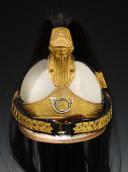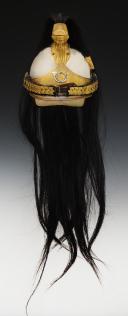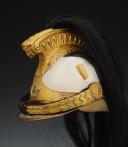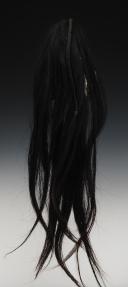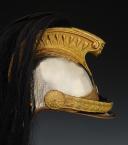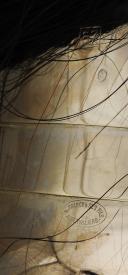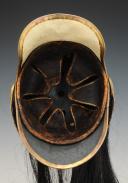
OFFICER HELMET OF HUSSARS ON HORSEBACK, model 1910 described in 1913, Third Republic. 29562R
Sold out
OFFICER HELMET OF HUSSARS ON HORSEBACK, model 1910 described in 1913, Third Republic. 29562R
One-piece helmet made of nickel-plated steel sheet. It is pierced at the top with six suction holes. Stamped with size "57" and manufacturer "BERNARD FRANCK & FILS - AUBERVILLIERS" with the stamp "A".
Nickel-plated steel visor edged with a 8mm wide golden brass strip placed overlapping the outer edge. Visor lined with green waxed basane. The nape cover is identical to the visor lined with ochre calfskin.
Golden brass headband stamped with a radiant sun on a sandblasted background, 6.5 cm in height. In the center, there is an added hunting horn made of German silver, 3 cm in height, with a width of 4.9 cm.
Each chinstrap is composed of 11 golden brass scales in the shape of laurel leaves with a scalloped edge, decreasing in width from the top scale, which is 2.7 cm, to the last one, which is just 2 cm. The scales are attached to a leather chin strap lined with black velvet. The right chinstrap is equipped at its end with a small riveted golden brass plate to which a buckle, also in golden brass, is attached. At the end of the left chinstrap, there is a similar plate holding a golden brass "D" garnished with a black varnished calfskin counter-sanglon. The top scale of each chinstrap is covered with a circular golden brass rosette, 4 cm in diameter, stamped with laurel leaves.
Golden brass crest composed of two fins, a mask, and a covering.
The fins are stamped with a decreasing series of thirteen gadroons with a beaded edge separated at the bottom by a water leaf and at the top by a floral design; the top part has a double prominent molding, the bottom part is folded outwards, scalloped, stamped with water leaves; each fin is attached to the helmet with two golden brass screws. Height of fins 6 cm.
A tin-plated plate joins the top edges of the fins, fixing their spacing.
The mask is stamped with vertical flat moldings separated by a striated background with a small palmette at the bottom and a Medusa head at the top, mask's height of 8.5 cm. The covering, also stamped, represents the continuation of the Medusa head's hair with intertwined snakes (length 9 cm).
Black horsehair mane, length approximately 75 cm.
Golden brass plume holder engraved with water leaves, tubular in shape with a square section, slightly narrowing towards the bottom, 3.5 cm in height.
Interior lining in black waxed leather cut into seven teeth with gilded edges.
France.
Third Republic.
Very good condition.
NOTE ON THE HELMETS OF HUSSARS ON HORSEBACK AND HUSSAR HELMETS model 1910:
After numerous trials of headgear, this model was selected as the standard model. Its deployment was slow and interrupted by the Great War. It was adopted in 1910, but it was not until September 22, 1913, that its description was published in the official military bulletin.
On April 27, 1910, "La France Militaire" reported that the lightened helmet of the dragoons "is being tested in a regiment of hussars on horseback - the 17th or 18th of Lunéville - and at the 6th, a hussar regiment of Commency".
In April 1911, the 5th regiment of hussars on horseback of Châlons took part in the autumn maneuvers wearing the model 1910 helmet.
However, after its introduction, this helmet remained stored in the clothing stores as part of the war collection. While eight hussar regiments received it after the start of hostilities in 1914, only the 5th regiment was wearing it at the mobilization. The 1911 trials closing report noted that the helmet was considered the ideal headgear for light cavalry. Budget credits of 66,444 francs in 1913 and 140,000 francs in 1914 were allocated for its distribution in seventeen light cavalry regiments, but it took a year of war for twelve of them to finally receive it starting from June 1915 (possibly thirteen regiments including the 3rd hussars, although there is no written proof, period photos confirm this).
This helmet never became the standard for light cavalry officers pre-war, as evidenced by the absence of its description in the April 1914 edition of volume 104 of the official military bulletin maintaining the shako as the standard headgear. After the outbreak of hostilities, the helmets issued to officers were of the troop type, following the ministerial decision of November 24, 1914.
On April 22, 1914, the Minister of War stated having 3,800 hussar helmets and 1,880 hussar helmets available: "these resources allow for issuing the helmet to five hussar regiments, to four squadrons or three regiments with six squadrons, and to equip two hussar regiments with four squadrons, and to set up, in the depots of the relevant units, a reserve of helmets for the equipment of reinforcements". The text adds, "the 1st, 5th, 13th (non-accurately noted in pencil), 15th, and 20th hussars would already be equipped with the helmet. The introduction of helmets will make a considerable quantity of shakos available, specifies the Minister to General Joffre".
The distribution of helmets continued during the summer in strict compliance with the April specifications: 2nd and 4th hussars on June 10, 14th hussars on June 23, 10th hussars on July 15 (received only on July 10,1915), 13th hussars on July 16, 17th and 18th hussars on July 31. The 8th hussar regiment was the only one in its arm subdivision to have received the 1910 model helmet before August 1914. The 15th hussar regiment received the helmet on March 11, 1915.
The 1st hussar regiment was equipped with the helmet instead of shakos by a decision on October 3, 1915, as reported in the military official journal. However, it is most likely that it was the Adrian helmet.
One-piece helmet made of nickel-plated steel sheet. It is pierced at the top with six suction holes. Stamped with size "57" and manufacturer "BERNARD FRANCK & FILS - AUBERVILLIERS" with the stamp "A".
Nickel-plated steel visor edged with a 8mm wide golden brass strip placed overlapping the outer edge. Visor lined with green waxed basane. The nape cover is identical to the visor lined with ochre calfskin.
Golden brass headband stamped with a radiant sun on a sandblasted background, 6.5 cm in height. In the center, there is an added hunting horn made of German silver, 3 cm in height, with a width of 4.9 cm.
Each chinstrap is composed of 11 golden brass scales in the shape of laurel leaves with a scalloped edge, decreasing in width from the top scale, which is 2.7 cm, to the last one, which is just 2 cm. The scales are attached to a leather chin strap lined with black velvet. The right chinstrap is equipped at its end with a small riveted golden brass plate to which a buckle, also in golden brass, is attached. At the end of the left chinstrap, there is a similar plate holding a golden brass "D" garnished with a black varnished calfskin counter-sanglon. The top scale of each chinstrap is covered with a circular golden brass rosette, 4 cm in diameter, stamped with laurel leaves.
Golden brass crest composed of two fins, a mask, and a covering.
The fins are stamped with a decreasing series of thirteen gadroons with a beaded edge separated at the bottom by a water leaf and at the top by a floral design; the top part has a double prominent molding, the bottom part is folded outwards, scalloped, stamped with water leaves; each fin is attached to the helmet with two golden brass screws. Height of fins 6 cm.
A tin-plated plate joins the top edges of the fins, fixing their spacing.
The mask is stamped with vertical flat moldings separated by a striated background with a small palmette at the bottom and a Medusa head at the top, mask's height of 8.5 cm. The covering, also stamped, represents the continuation of the Medusa head's hair with intertwined snakes (length 9 cm).
Black horsehair mane, length approximately 75 cm.
Golden brass plume holder engraved with water leaves, tubular in shape with a square section, slightly narrowing towards the bottom, 3.5 cm in height.
Interior lining in black waxed leather cut into seven teeth with gilded edges.
France.
Third Republic.
Very good condition.
NOTE ON THE HELMETS OF HUSSARS ON HORSEBACK AND HUSSAR HELMETS model 1910:
After numerous trials of headgear, this model was selected as the standard model. Its deployment was slow and interrupted by the Great War. It was adopted in 1910, but it was not until September 22, 1913, that its description was published in the official military bulletin.
On April 27, 1910, "La France Militaire" reported that the lightened helmet of the dragoons "is being tested in a regiment of hussars on horseback - the 17th or 18th of Lunéville - and at the 6th, a hussar regiment of Commency".
In April 1911, the 5th regiment of hussars on horseback of Châlons took part in the autumn maneuvers wearing the model 1910 helmet.
However, after its introduction, this helmet remained stored in the clothing stores as part of the war collection. While eight hussar regiments received it after the start of hostilities in 1914, only the 5th regiment was wearing it at the mobilization. The 1911 trials closing report noted that the helmet was considered the ideal headgear for light cavalry. Budget credits of 66,444 francs in 1913 and 140,000 francs in 1914 were allocated for its distribution in seventeen light cavalry regiments, but it took a year of war for twelve of them to finally receive it starting from June 1915 (possibly thirteen regiments including the 3rd hussars, although there is no written proof, period photos confirm this).
This helmet never became the standard for light cavalry officers pre-war, as evidenced by the absence of its description in the April 1914 edition of volume 104 of the official military bulletin maintaining the shako as the standard headgear. After the outbreak of hostilities, the helmets issued to officers were of the troop type, following the ministerial decision of November 24, 1914.
On April 22, 1914, the Minister of War stated having 3,800 hussar helmets and 1,880 hussar helmets available: "these resources allow for issuing the helmet to five hussar regiments, to four squadrons or three regiments with six squadrons, and to equip two hussar regiments with four squadrons, and to set up, in the depots of the relevant units, a reserve of helmets for the equipment of reinforcements". The text adds, "the 1st, 5th, 13th (non-accurately noted in pencil), 15th, and 20th hussars would already be equipped with the helmet. The introduction of helmets will make a considerable quantity of shakos available, specifies the Minister to General Joffre".
The distribution of helmets continued during the summer in strict compliance with the April specifications: 2nd and 4th hussars on June 10, 14th hussars on June 23, 10th hussars on July 15 (received only on July 10,1915), 13th hussars on July 16, 17th and 18th hussars on July 31. The 8th hussar regiment was the only one in its arm subdivision to have received the 1910 model helmet before August 1914. The 15th hussar regiment received the helmet on March 11, 1915.
The 1st hussar regiment was equipped with the helmet instead of shakos by a decision on October 3, 1915, as reported in the military official journal. However, it is most likely that it was the Adrian helmet.
Reference :
29562R
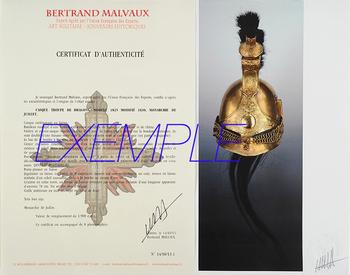
Next update Friday, december 19 at 13:30 PM
FOR ALL PURCHASES, PAYMENT IN MULTIPLE CHECKS POSSIBLE
bertrand.malvaux@wanadoo.fr 06 07 75 74 63
SHIPPING COSTS
Shipping costs are calculated only once per order for one or more items, all shipments are sent via registered mail, as this is the only way to have proof of dispatch and receipt.
For parcels whose value cannot be insured by the Post, shipments are entrusted to DHL or Fedex with real value insured, the service is of high quality but the cost is higher.
RETURN POLICY
Items can be returned within 8 days of receipt. They must be returned by registered mail at the sender's expense, in their original packaging, and in their original condition.
AUTHENTICITY
The selection of items offered on this site allows me to guarantee the authenticity of each piece described here, all items offered are guaranteed to be period and authentic, unless otherwise noted or restricted in the description.
An authenticity certificate of the item including the description published on the site, the period, the sale price, accompanied by one or more color photographs is automatically provided for any item priced over 130 euros. Below this price, each certificate is charged 5 euros.
Only items sold by me are subject to an authenticity certificate, I do not provide any expert reports for items sold by third parties (colleagues or collectors).
FOR ALL PURCHASES, PAYMENT IN MULTIPLE CHECKS POSSIBLE
bertrand.malvaux@wanadoo.fr 06 07 75 74 63
An authenticity certificate of the item including the description published on the site, the period, the sale price, accompanied by one or more color photographs is automatically provided for any item priced over 130 euros. Below this price, each certificate is charged 5 euros.
Only items sold by me are subject to an authenticity certificate, I do not provide any expert reports for items sold by third parties (colleagues or collectors).
